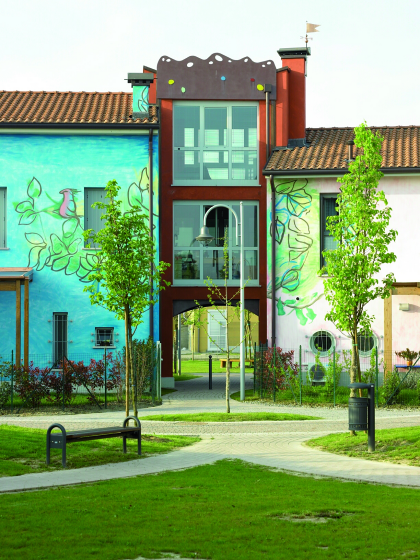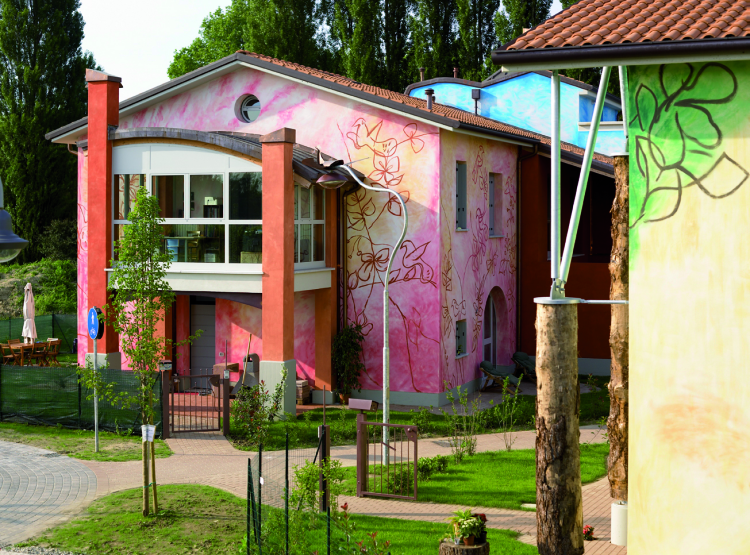CSR AT ANDRIA COOPERATIVA
Andria Cooperativa’s CSR reflects in its shift, in 1990, from a “pure house builder” to a resident-focused cooperative, aiming at empowering residents and supporting their active involvement in the community and improvement of their quality of life. To do this the Cooperative set up an original organisational structure which, via an intensive listening activity (members’ office), implements innovative projects (projects office), follows the work on-site and therefore guarantees its members a chance to customize their dwellings (works direction office). Each family is followed through the buying and financing process of the dwelling (administrative and finance office). With this “organised participation” method, the Cooperative can provide assurance with respect to decisional procedures, strategic objectives, quantity and quality of results, starting from the needs of the dwellers. OBJECTIVE
To create a new neighbourhood, based on children’s dreams and ideas, using a thorough participatory approach. CONTEXT
Over the years, Andria Cooperativa has helped many families to buy their first home, and has gained much valuable experience. The cooperative for home-building was transformed in 1990 into a Cooperativa di abitanti, a cooperative for dwellers; the significant change was that it desired to become more than just a house-builder, to establish itself as a point of reference for the dwellers who wanted to play a significant and active part in improving their own quality of life in the territory. So the centre of attention shifted from the houses to the dwellers - the people with their needs and wishes, their own dreams. To make this change, some aspects needed to come to the fore: listening, participation, sharing. DESCRIPTION OF THE GOOD PRACTICE
Coriandoline, a small neighbourhood project took its inspiration from a research carried out, with teachers, child psychologists and architects, among 700 children attending infant schools in the areas of Correggio and Rio Saliceto, to collect their living needs. Based on the information received, an exhibition of real models was held, involving children and the community, according to a participatory and communicative town planning concept. The expectations expressed by the children were further processed, to identify the strong points and define appropriate methods to make these ideas concrete.
In 1999, the “Manifesto of Children’s living needs” was developed, including a book (with the research’s results), a video (of the conversations with children) and an exhibition (with the materials produced by the children). This led, the following year, to the start of the actual construction project. A rough project outline was mapped out, which was then progressively corrected and improved throughout implementation. The proposed Neighbour-hood Urban Plan was presented and the architectural project developed, using a small-scale model to analyse perspectives and architectural details. In the presentation of the project, much effort was made to keep up the inter-disciplinary spirit that had developed during all the previous stages.
In 2004, after a long period of participation and intense customising efforts, the actual works started and the families built the homes they had wanted. The building work was done with special attention and care on the part of the construction company and the technical experts. Everybody involved had a special desire to make this project work and got carried away by the infectious enthusiasm of the whole team. Finally, the major works ended in 2006 and families started moving in. The new neighbourhood was inaugurated in 2008. Key results and benefits
- 10 flats constructed
- 10 families live currently in the Coriandoline area
- A little centre of documentation and social cohesion aggregation located in the Coriandoline
- Needs expressed by children and families have been taken into account, to result in attractive and autonomous dwellings and greater ownership of the neighbourhood by its residents
- Development of families’ knowledge on architecture and urban planning
- Materials, book and videos to document the process and record children’s ideas
Finalista
European Responsible Housing Awards 2014
Datos
Modalidad Good governance and fair relations with stakeholders



